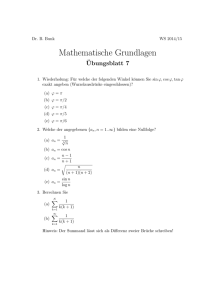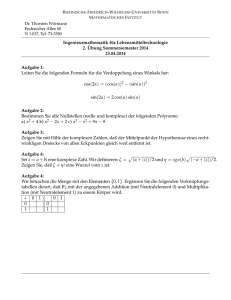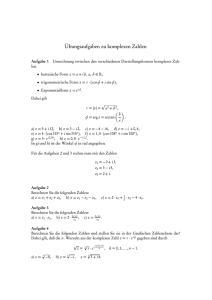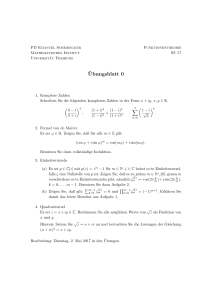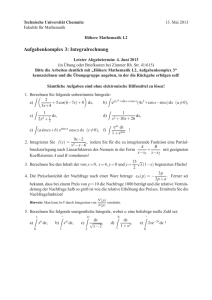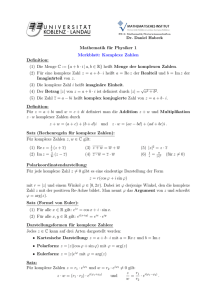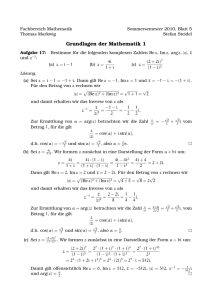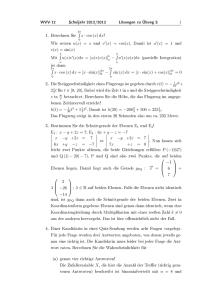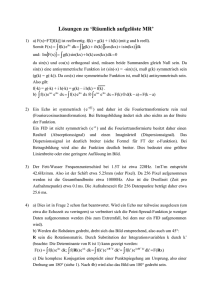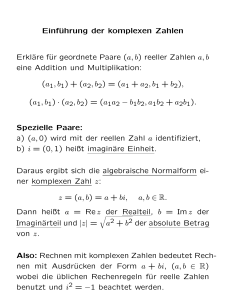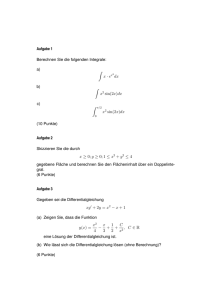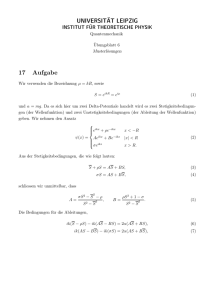coskx+bk sinkx
Werbung
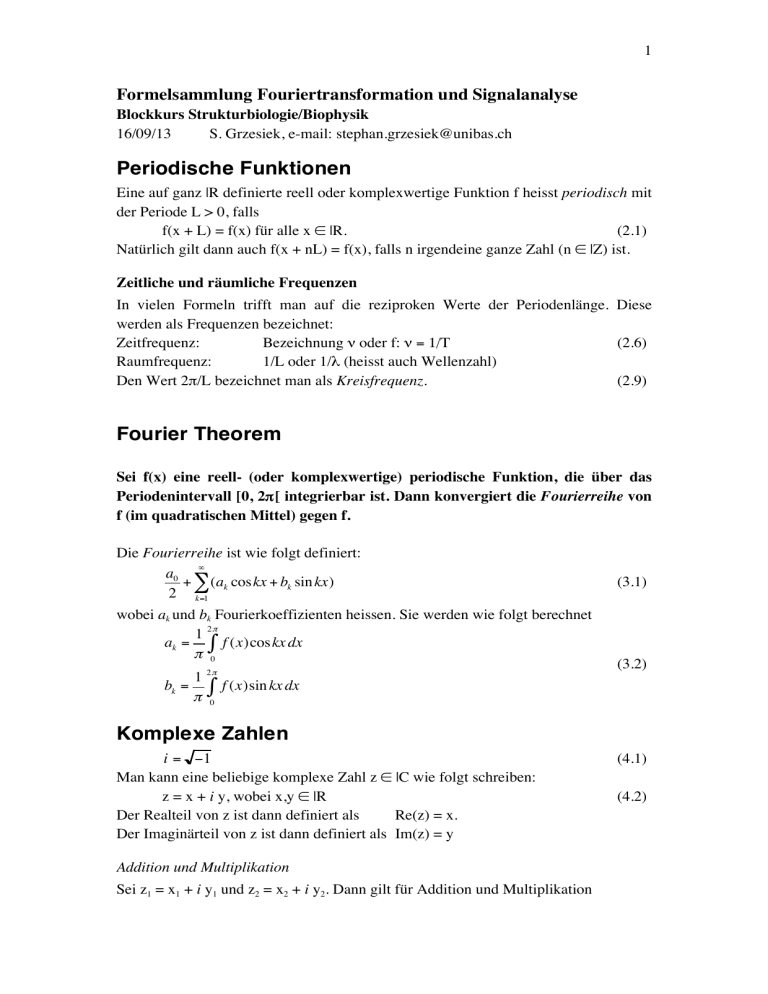
1 Formelsammlung Fouriertransformation und Signalanalyse Blockkurs Strukturbiologie/Biophysik 16/09/13 S. Grzesiek, e-mail: [email protected] Periodische Funktionen Eine auf ganz |R definierte reell oder komplexwertige Funktion f heisst periodisch mit der Periode L > 0, falls f(x + L) = f(x) für alle x ∈ |R. (2.1) Natürlich gilt dann auch f(x + nL) = f(x), falls n irgendeine ganze Zahl (n ∈ |Z) ist. Zeitliche und räumliche Frequenzen In vielen Formeln trifft man auf die reziproken Werte der Periodenlänge. Diese werden als Frequenzen bezeichnet: Zeitfrequenz: Bezeichnung ν oder f: ν = 1/Τ (2.6) Raumfrequenz: 1/L oder 1/λ (heisst auch Wellenzahl) Den Wert 2π/L bezeichnet man als Kreisfrequenz. (2.9) Fourier Theorem Sei f(x) eine reell- (oder komplexwertige) periodische Funktion, die über das Periodenintervall [0, 2π[ integrierbar ist. Dann konvergiert die Fourierreihe von f (im quadratischen Mittel) gegen f. Die Fourierreihe ist wie folgt definiert: a0 ! + " (ak coskx + bk sin kx) 2 k=1 wobei ak und bk Fourierkoeffizienten heissen. Sie werden wie folgt berechnet 1 2! ak = ! f (x)coskx dx ! 0 1 2! bk = ! f (x)sin kx dx ! 0 (3.1) (3.2) Komplexe Zahlen i = !1 Man kann eine beliebige komplexe Zahl z ∈ |C wie folgt schreiben: z = x + i y, wobei x,y ∈ |R Der Realteil von z ist dann definiert als Re(z) = x. Der Imaginärteil von z ist dann definiert als Im(z) = y Addition und Multiplikation Sei z1 = x1 + i y1 und z2 = x2 + i y2. Dann gilt für Addition und Multiplikation (4.1) (4.2) 2 z1 + z2 = (x1 + iy1 ) + (x2 + iy2 ) = (4.4) = (x1 + x2 ) + i(y1 + y2 ) z1 " z2 = (x1 + iy1 ) " (x 2 + iy 2 ) = = x1 x 2 + ix1 y 2 + iy1 x 2 # y1 y 2 = = (x1 x 2 # y1 y 2 ) + i(x1 y 2 + y1 x 2 ) (4.5) Komplexe Konjugation ! z* = x – iy (4.6) Betrag einer komplexen Zahl z = z ! z* = (x + iy)(x " iy) = (4.7) = x 2 + ixy " ixy " i 2 y 2 = x 2 + y 2 Gauss’sche Zahlenebene Im z iy r φ 0 x Re r = z = x 2 + y2 cos ! = x / r sin ! = y / r tan ! = y / x (4.8) ! = arctan y / x = arccos x / r = arcsin y / r z = r(cos ! + isin ! ) = x + iy Komplexe e-Funktion Für die e-Funktion eines rein imaginären Arguments (iφ) gilt die Eulersche Beziehung ei! = cos ! + isin ! = "cis"(! ), ! reell z = z (cos ! + isin ! ) = z ei! (4.9) (4.10) 3 ei! + e!i! 2 i! e ! e!i! sin ! = 2i cos ! = (4.11) Komplexe Fourierreihe # f (x) ! $c e ikx (5.1) k k="# 2! ck = 1 2! " f (x)e!ikx dx = 0 1 2! 2! " f (x) [cos(!kx) + isin(!kx)] dx (5.2) 0 a0 2 1 1 ck = (ak ! ibk ), c!k = (ak + ibk ) für k " 1 2 2 c0 = (5.3) Diskrete Fourieranalyse im Computer ck = 2! 1 2! " F(x)e!ikx dx # 0 N!1 1 ck = $ ym e N m=0 N!1 ym = " ck e 1 2! N!1 $ F(xm )e!ikxm %x = m=0 1 2! N!1 $ yme m=0 !i 2 ! km N 2! N 2 ! km !i N 2 ! km N +i (6.1) (6.2) k=0 Powerspektrum Die Grösse |ck|2 bezeichnet man als die spektrale Leistungsdichte im Frequenzintervall [k/L, (k+1)/L]. Kontinuierliche Fouriertransformation F(k) ! 1 2! # $ f (x)e "ikx (8.1) dx "# " f (x) = # F(k)e ikx (8.2) dk !" Mehrdimensionale Fourierreihen und -integrale Fourierreihen: # f (x, y, z) ! # # $ $ $c hkl h="# k="# l="# ei(hx+ky+lz) (9.1) 4 chkl = 2! 2! 2! 1 ( 2! ) " " " f (x, y, z)e 3 !i(hx+ky+lz) dxdydz (9.2) 0 0 0 Kontinuierliche Fouriertransformation: " " " f (x, y, z) = # # # F(h, k, l)e i(hx+ky+lz) (9.3) dhdkdl !" !" !" F(h, k, l) ! # # # 1 ( 2! ) 3 $ $ $ f (x, y, z)e "i(hx+ky+lz) dxdydz (9.4) "# "# "# Elementare Eigenschaften der Fouriertransformation Seien f(x) ⇔ F(k) = FT[f(x)] und g(x) ⇔ G(k) = FT[g(x)] Fouriertransformationspaare, a und b komplexe Zahlen, und s, x0, k0 reelle Zahlen. Dann gilt: Linearität: FT[a ! f (x) + b ! g(x)] = a ! FT[ f (x)]+ b ! FT[g(x)] = a ! F(k) + b ! G(k) Skalierung im Orts- oder Zeitraum: 1 k f (s ! x) " F( ) s s Skalierung im Frequenzraum: 1 x f ( ) ! F(s " k) s s Zeit- oder Ortsverschiebung: f (x ! x0 ) " F(k)e!ikx0 Frequenzverschiebung: f (x)eik0 x ! F(k " k0 ) (10.1) (10.2 (10.3) (10.4) (10.5) Faltungstheorem Seien f(x) ⇔ F(k) = FT[f(x)] und g(x) ⇔ G(k) = FT[g(x)] Fouriertransformationspaare und s eine reelle Zahl. Die Faltung (Konvolution) der beiden Funktionen f und g, Bezeichnung f⊗g, ist folgendermassen definiert: % [ f ! g](x) " & f (s)# g(x $ s)ds (12.1) $% Faltungstheorem: [ f ! g](x) " F(k)# G(k) (12.2) Mit anderen Worten: die Fouriertransformation einer Faltung zweier Funktionen ist einfach das Produkt der Fouriertransformierten der Einzelfunktionen. Formula(from(the(fields(of(Optics(and(Electron(Microscopy((Lectures(Stahlberg)( ( 1 1 1 1)(Basic(lens(equation:( + = ( a b f ( b 2)(Magnification:( M = − ( a ( n⋅λ 3)(Diffraction(angle(θn(of(the(nEth(diffraction(order:( Θ n = ,( g with:(λ=wavelength,(g=lattice(constant.( This(approximation(is(only(valid(for(smaller(angles(θn.( ( 1.22 ⋅ λ 1.22 ⋅ λ 4)(Resolution(of(a(perfect(lens:( d = ( = 2 ⋅ NA 2 ⋅ n ⋅sin(Θ max ) with:(λ=wavelength,(NA=Numerical(Aperture,(n=refractive(index(of(medium(outside( of(lens((1.0(for(air,(1.33(for(pure(water,(1.56(for(oil),(θmax(=angle(between(the(optical( axis(and(the(edge(of(the(lens(aperture((=(half(lens(diameter).( ( 5)(Fourier(Theorem:(( g(x) = h(x) ⊗ f (x) (((in(realEspace(is(equivalent(to( G(u) = H(u) ⋅ F(u) (in(Fourier(space,( in(other(words:((convolution(in(realEspace(is(multiplication(in(Fourier(space.( ( 6)(Laue(Diffraction(law(for(diffraction(when(traversing(a(doubleEslit:( d ⋅ sin(Θ) = n ⋅ λ ( with(d=slit(distance,(θ=diffraction(angle,(n=diffraction(order,(and(λ=wavelength( ( 7)(Bragg(Diffraction(law(for(reflection(in(a(crystal(lattice:( 2 ⋅ d ⋅ sin(Θ) = n ⋅ λ ( with(d=atomic((or(molecular)(layer(distance(within(crystal,(θ=reflection(angle(with( respect(to(the(atomic((or(molecular)(layer(plane,(n=diffraction(order,(and( λ=wavelength( ( Appendix: Formulary Fundamental numeric constants J cal • Gas constant: R = 8.314 K·mol = 1.988 K·mol • Boltzmann constant: kB = 1.381 · 10 • Planck constant: h = 6.626 · 10 34 23 J K J·s • Calorie: 1 cal = 4.184 J Thermodynamics and reaction kinetics The chemical potential and the chemical equilibrium µi = µi + RT ln{Xi } rG = rG + RT ln k Y i=1 rG = {Xi }⌫i RT ln Keq Denaturation of a protein G= GH2 O + m [Denaturant] Kinetics of a monomolecular reaction A ! P v(t) = d [A] = k · [A] dt k·(t t0 ) [A] = [A]0 · e Kinetics of a bimolecular reaction A + B ! P v(t) = d [A] = dt d [B] = k · [A] · [B] dt ✓ ◆ [A]0 ) k (t t0 ) kB T = exp h ✓ ln [B] [A]0 [A] [B]0 = ([B]0 Transition state theory kB T k= exp h ✓ G‡ RT ◆ S‡ R ◆ 36 exp ✓ H‡ RT ◆ Michaelis-Menten kinetics v= k2 [S] [E]0 KM + [S] KM = k + k2 k1 1 Lineweaver-Burke equation 1 KM 1 1 = · + v k2 [E]0 [S] k2 [E]0 37 Blockkurs in Strukturbiologie und Biophysik Formelsammlung Röntgenkristallographie 1 r r r r r S := s f / " # so / " = ( s f # so ) / " rr r Phasenverschiebung der vom Atom j am Ort rj gestreuten Teilwelle: " j = 2# rj S Definition des Streuvektors: r 2 sin(") |S | = # ! ! Länge des Streuvektors ( !: halber Streuwinkel): ! N Atome r r i# F (S ) := " f j e j Strukturfaktor eines einzelnen Moleküls (fj: Atomformfaktor vom Atom j): j=1 ! r r F (S ) = Strukturfaktor eines einzelnen Moleküls ("(r): Elektronendichte): ! r r r Laue-Gleichungen ( a , b , c sind die Basisvektoren ! der Einheitszelle; h, k, l sind ganze Zahlen): r * r * r!* ! ! ! Definiton der reziproken Gitters ( a , b , c ): ! ! ! Laue-Bedingung ausgedrückt als Bedingung ! für Streuvektor: Strukturfaktor einer Kristallstruktur: ! r Fhkl = oder: Molekülvolumen r r r r r r a " S = h, b " S = k, c " S = l r r a " a* = 1 r r b " a* = 0 r r c " a* = 0 r r* a"b = 0 r r b " b* =1 r r* c "b = 0 r r a " c* = 0 r r b " c* = 0 r r c " c* =1 r r r r r S = Shkl = h " a * + k "b * + l " c * r 2 #i (hx j +ky j +lz j ) Fhkl = " f j e j # " (x, y,z)e 2 $i (hx+ky+lz) drx drydrz Volumen der Einheitszelle ! ! r 2 $ i rr Sr dV # " (r ) e Blockkurs in Strukturbiologie und Biophysik Formelsammlung Röntgenkristallographie 2 Elektronendichte als Fouriersynthese: " (x, y,z) = 1 r | Fhkl | e#i[ 2 $ (hx+ky+lz)#% hkl ] ' ' ' V h=#& k=#& l=#& & & & in 1D und reeler Schreibweise: ! & r " (x) = 1 {| F0 | +2 ' |F h | cos(2#hx $ % h )} a h=1 d min = Auflösung: ! " 2 sin (# max ) r r r R = " | | Fobs | # | Fcalc | | / " | Fobs | R-faktor: ! hkl hkl Mathematik Skalarprodukt von Vektoren (!: eingeschlossener Winkel): rr r r x = a b = a b cos(" ) r r r r r a x = a0 b = b cos(" ) , d.h. x ist Länge der Projektion von b auf falls 0 Einheitsvektor: r Richtung a0 ! ! ! komplexe Zahl ! ! ! ! r r c : c = a+ib r c = r ei" Euler-Gleichung: ! ei" = cos(" ) + i sin(" ) ! Formulas for AFM: Hooke’s Law: F [N] = k [N/m] × x [m] Deflection/Force Sensitivity (DS): Ω = ΔV/ΔZ [V/nm] Formulas: Correlating affinity to binding energy: KA = e € −ΔG° RT , ∆G° is a free Gibbs energy of this reaction at standard conditions (25°C, 1 M concentrations and 1.013 bar) R is the Universal Gas Constant 8.3143 Jmol-1K-1 T is the absolute temperature Langmuir Isotherm: Req = Rmax × CA K D + CA , KA is the equilibrium binding constant Req is the equilibrium binding capacity Rmax is the maximal binding capacity CA is the analyte concentration in solution Correlation between the equilibrium binding constant (KA) and the equilibrium dissociation constant (KD) KA = € 1 KD
